 Staff member Jeff Smith was a 24-handicap golfer who has only really gotten serious about his golf game last year (2005). Jeff is a strong golfer who fits an over-the-top move that, combined with his tremendous clubhead speed, leads to even more tremendous slices.
Staff member Jeff Smith was a 24-handicap golfer who has only really gotten serious about his golf game last year (2005). Jeff is a strong golfer who fits an over-the-top move that, combined with his tremendous clubhead speed, leads to even more tremendous slices.
Jeff mistakenly ordered regular flex shafts in his clubs, and with a driver swing speed of 100 MPH, suffice to say he’s playing the wrong shafts. The regular flex shafts alone probably account for 50% of his troubles off the tee and a smaller fraction of his troubles with the irons. But that’s not what this column is about, so let’s give Jeff a Swing Check!
Jeff’s other major issue is one of quality of contact: he hits shots fat, he hits shots thin, and occasionally he catches one just right… yet pulls it left or cuts it right.
That being said, Jeff’s swing is quite sound, and with only a few changes, Jeff should see a dramatic improvement in both his ballstriking and his slice.
Address
Jeff’s position at address is a bit too “over the ball,” particularly with a driver. A descending blow with the driver increases backspin, which leads to a ballooning ball flight and a severe loss of distance. It also exaggerates any over-the-top, out-to-in move, causing hard pulls and wild slices. Jeff’s stance is a little narrow, too, and his ball position – though good relative to his left foot – is far too close to the center of his body.
Jeff would do well to mirror Tiger Woods (of 1999). Tiger sets his head behind the ball and employs a wide stance. The ball is just as far back from his front foot as in Jeff’s stance, but you can see that the extra width moves the ball position forward relative to the center of the body. This will lead to a sweeping blow that minimizes popups. Jeff would also have more room to come down the target line (or slightly from the inside) to minimize the over-the-top move.
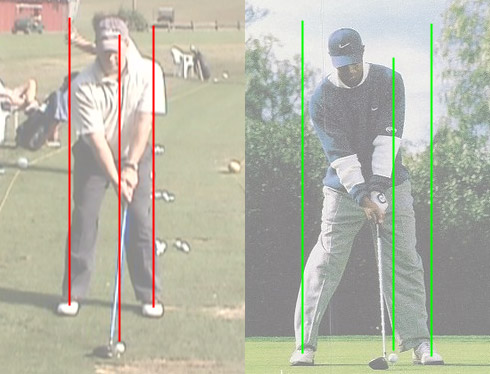
Jeff’s stance suffers from one main problem: it’s not wide enough!
Though widening the stance is the largest problem, you can see here in the same photos that Jeff should adjust one more thing: his spine angle. By leaning away from the target just a bit as Tiger is doing, you establish an early weight shift to your back side. Your swing then becomes much more about rotation on the backswing than a weight shift, allowing you to focus on coiling your body before unleashing it at the ball.
Tilting away from the ball will also bring the hands back, putting the shaft in a more vertical or even leaned-back position. The driver is a unique club in that you want to catch it flat or on a slight upswing, so pre-setting yourself in this position will help you return there on the downswing.
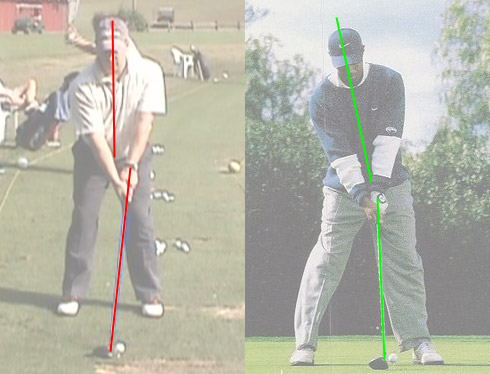
Lean away, Jeff Smith, lean away!
Transition
Jeff largely overcomes some of the problems he had at setup to make a good weight shift and a good coil. His transition at the top has both good and bad elements.
The good elements are highlighted in green. First, I’ve circled his hands on the backswing and downswing. You’ll note that they’re in the same position relative to his shoulders. That’s good. Second, the shaft angle and entire swing plane on the downswing is good – it points just inside the ball, promoting a good angle of attack from the inside or down the target line.
Unfortunately, and while Jeff’s hands are in the same plane throughout his swing, the club shaft is not. Jeff lets the shaft get a little laid off during his backswing, both most of the way back (frame 1) and at the top (frame 2). The clubface itself at the top is square, and that’s good, but a bit more of an upright swing plane would do Jeff well. If it looks as though Jeff is attempting to compensate for his narrow stance by trying to flatten his shaft plane, he is.
A swing plane that goes flat to upright is guaranteed to come over the top, and that’s what we see here.
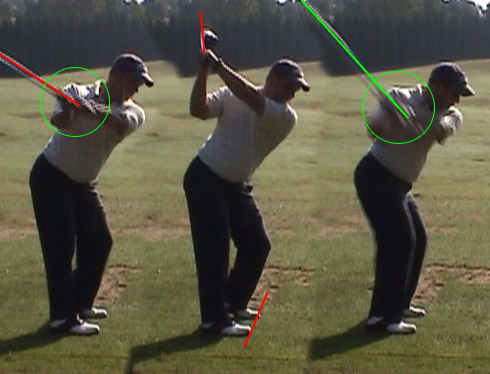
Jeff does good and bad things on his backswing: he’s laid off with the club, but his hands are always in-plane.
Impact
This one’s pretty easy: unless your name is “David Duval” or “Annika Sorenstam,” watch the blade of grass behind the ball rather than attempting to watch the ball itself. Jeff moves his head throughout the swing. Even if he manages to do so without changing his height, it’s bound to move the bottom of the swing slightly. Keep that head looking down until after impact and let the rotation of your body (and your right shoulder) bring it up to view the shot.
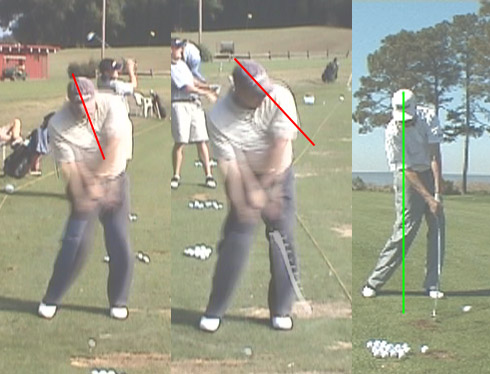
It’s odd that in golf, you produce the best shots when you try not to watch them and you produce the worst when you look up to see the whole thing.
Jeff has one other minor issue at impact: his spine angle changes. Largely this may be a function of his “over-the-top” move set up at address and during the backswing (narrow stance, flat-to-upright transition), but the head movement we saw above may also be affecting his spine angle. When you swing out-to-in, your body has to get out of the way of your arms, and oftentimes it does this by straightening out or “standing up” a bit.
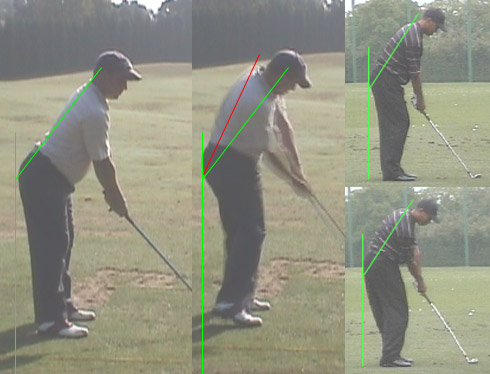
Jeff’s spine angle change is likely a setup and transition issue.
Finish
In Tiger’s shots, we see how the shoulders look when you come at the ball from the inside or down the target line. Jeff’s shoulders are well open after impact, already pointing left of the target even before the end of the follow-through. There’s really nothing “wrong” with this position because the ball is long gone – but it’s virtually impossibly to get into this position with a full swing without an over-the-top move.
In other words, though these positions aren’t anything you should try to correct, they are further proof of the over-the-top move.
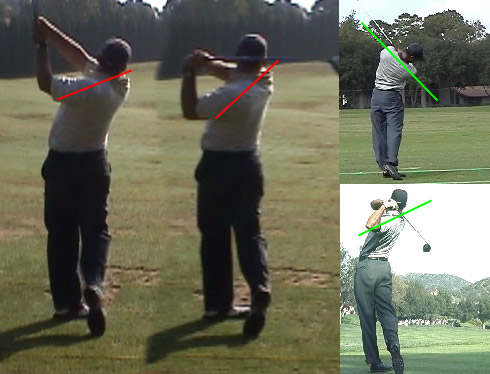
If your arms come down the target line, your chest and shoulders won’t open up so quickly. This is not a fault, but proof of an earlier fault.

Good writeup. I like this series and look forward to more.
Do you know if there are any implications behind doing a writeup like this, aka giving lessons and having a non-professional status? Unless you are a pro?
Just curious. It’s one of those things I talked with the USGA about and my own site but never got a real clear answer out of them.
We’re not being paid to do the lessons. And that’s if you call them lessons to begin with. They’re more like analysis.
Golf Digest authors help to write and publish swing tips, lessons, etc. Doesn’t make them professional golfers either.
There shouldn’t be any confusion here. The USGA is clear.
If I recall correctly, you were asking for money to analyze people’s videos. That is obviously in violation of the rules of amateur status.
Nice dissection, Erik. One more thing I would add: In the fifth picture from the top Jeff has bent too much from the hips. This makes his center of gravity much too close to the ball. A vertical line drawn from the back of the right tricep should dissect the kneecap and between the ball and toe of the right foot.
This is a reason why he breaks his spine angle coming down to impact. If he didn’t, he would topple over towards the ball.
So Jeff, if you’re reading this, try setting up so that you can feel your weight balanced in the middle of your foot, and in a manner that makes you feel you could quickly move in any direction. This will establish a much more stable base for you and from there you’ll be able to make a very athletic swing!
One thing he does rather well is that he keeps his rear end planted on the same point at impact as it is at address, it might even come off the ball a little bit, which is something Tiger does a little bit more today than he did in his ’99 swing.
I’m listening. While I think my swing has changed a bit from this sequence, I am still moving away from some of these tendencies. The over-the-top move introduced a bunch of compensations that I’m having to unlearn.
I believe I’m doing better staying away from the laid off position in the backswing and I’m trying ever so hard to stay balanced… thanks for the reminder Jeff.
I’m looking forward to reviewing some video in the near future to see how I’m progressing.
NICE WORK…MOST OF WHAT YOU SHOWED AGREED
WITH WHAT MY TEACHING PRO AT GOLF TEC WORKED WITH ME ON….. AT $50 A HALF HR
KEEP IT COMMING